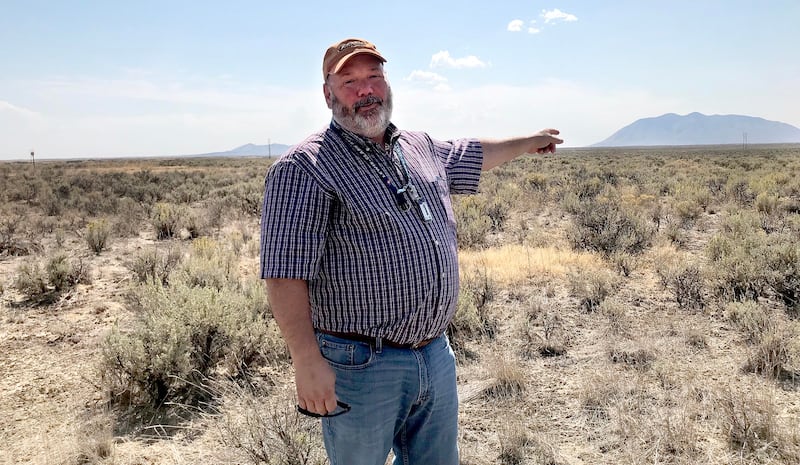SALT LAKE CITY — As the next station approaches for cities and special service districts to potentially disembark from additional financial investment in next-generation nuclear technology, Utah lawmakers are seeking more details on NuScale Power’s Small Modular Reactor plant.
“I like the solution of nuclear power,” said Rep. Kay Christofferson, R-Lehi, but expressed concern after his home city jumped off the train last month, along with Logan, with both citing concerns over costs.
The Public Utilities, Energy and Transportation committee on Wednesday heard an update on the Carbon Free Power Project that is being pursued by the U.S. Department of Energy and the Utah Associated Municipal Power Systems — a political subdivision of the state of Utah representing 47 cities or special service districts that provide energy.
Cities and districts invested in the plant have until Oct. 31 — one of several so-called off-ramps — to bow out of the project.
During the committee hearing, Sen. Ron Winterton, R-Roosevelt, shared his concerns over the cities’ financial commitments.
“I want to feel warm and fuzzy” he said, but questioned the technology and potential risks.
Mike Squires, government affairs director for the energy coalition, said the contractual arrangements with member cities and districts are designed to safeguard their autonomy and level of risk, while at the same time provide an investment that helps pay for the plant.
While the project’s planned 720 megawatts is only 30% subscribed, Squires said more cities are expressing interest even as Logan and Lehi dropped off.
“We are eager to get this online, but we are also very cognizant of the fact that we want to do this right, not just quickly,” Squires said.
Under both the Obama and the Trump administrations, the NuScale project has received strong financial support, Squires said. The federal energy agency gave NuScale a competitive award of $226 million in 2013 to develop the technology. Two years later, the federal agency gave NuScale $16.7 million for licensing preparation.
The plant’s unique design features 12 distinct modules, with the first scheduled to come online in 2029 and the 11 others following the next year. Its passive cooling system and small geographic footprint make it far different than traditional nuclear power plants.
In late August, NuScale’s Small Modular Reactor was the first technology in the United States to receive design certification from the U.S. Nuclear Regulatory Commission, which gave its stamp of approval for its safety features.
There is a global race on which country will be the first to deploy the technology, with NuScale in the lead for its plant destined for about 35 acres at Idaho National Laboratory.
The Portland-based company has also inked agreements with other countries interested in using the Small Modular Reactor technology that include Canada, Romania, the Czech Republic, and Jordan. Similar agreements with other entities are being negotiated as well, according to the company.
Facing the prospect of aging coal plants being retired and no new plants coming online, municipal power providers are seeking to diversify their energy portfolio by securing a stable source of base power to take the place of coal and augment renewables such as wind and solar.
Critics like the Utah Taxpayers Association, however, say the investment by Utah cities is too risky and they should not be acting as seed investors.
“We are not opposed to nuclear power, we are opposed to the financial risk,” said the association’s vice president, Rusty Cannon.
But some of these municipal power providers say they see the risk of doing nothing just as great.
“One of the things we are concerned about is what the future holds and where are we going to get our next resource,” said Jack Taylor, manager of Santa Clara City Power.
“In the next 10 to 15 to 20 years, we have to look at where we are getting our power. What is our plan B?” Taylor said. “So you have to look at what your risks are in the future, versus what the risks are of building this plant. If we can build this plant at $55 per megawatt hour, we can afford that. That will work with our system, with our power rates.”
Taylor recalled the skyrocketing of natural gas prices about 20 years ago, when providers were paying nearly $14 per 1,000 cubic feet of natural gas. Today’s price, which is pretty cheap, sits at about $2.25 per 1,000 cubic feet, but Taylor said most people in the energy business expect that to go up.
When those prices shot up, Taylor added, providers were paying more than $300 per megawatt-hour of energy, so the NuScale project feels like a safer bet to rely on.
Dave Burnett, manager of Brigham City Power, said the city needs only to look at the volatility of California’s power prices to understand the need for securing a reliable base load supply of energy.
“It is a big risk; I think that is what might be scaring some of the cities,” he said. “When you look at a project like this, there are a lot of players involved, but if I look at the whole big picture of everything, no matter what we do there will be risk. Right now, all of our eggs are in one basket.”
Burnett said if that basket were to collapse the city could be in an untenable situation like California, which this summer has experienced rolling blackouts and price spikes of energy of more than $1,000 per megawatt-hour.
A megawatt-hour, according to the PJM Learning Center, can cool a refrigerator for three months, supply enough energy for 600 Super Bowl parties or charge 5,556 iPhones.
Now that the NuScale project has passed the design and safety certification phase, the company has contracts in place for its supply chain for customers, including engineering, construction, the use of next-generation fuel technology and “proof of concept testing” for the reactor building crane, according to Diane Hughes, vice president of marketing and communications at NuScale Power.


